| THE STOCKYARDS: |
Long since gone to join the buffalo
and modesty in women, the local stockyards was a sizeable and colorful
and - when the wind was right - a pungent business. Always Saturday,
frequently Wednesday, were "shipping days" for hogs. Cattle were shipped
any day the feeder-shipper chose. On the new elevator-towers site, it
was operated in early 1900's by Hill and Slocum (Ed and John) and later,
for 19 years, by Hill & (John) Burket.
Friday at our house was "hog night". Farmers phone continuously, asking
price-bids. Mother never, ever entertained on that night. She was
mortified to tears by Dad's vocabulary pricing "stage. boars and wet
sows", along with top young hogs. She - was further bedeviled by Dad's
mannerisms at the phone. A little man, he strained upward at the
too-high crank-phone, placing his right foot on the window sill, he wet
the pencil point, wrote down names and numbers, then scratched his
bottom with the pencil-point. It was just his private way of doodling.
It was work but thrilling to help at the yards. Socially, it was a
forerunner of the Sale Barn. Above the din of squealing, overheated hogs
in waiting wagons were the shouts of farmers, belching steam trains
"spotting" cars at the chute, and as old Sandow one-lunger gasoline
engine pumping water all day long to wet and cool the suffering hogs and
prepare sanded cars for loading. Above it all, I hear Dad: "Pen these in
middle-west lot - and hurry up". Always, it was "hurry up". Often we
loaded out at 3 a.m. Sunday in hot weather. Trucks have altered all that
and wiped out something fascinating and stable and colorful in the realm
of barter and trade in Minturn. Honor was presumed. No weighers had to
be "bonded". Often Hill or Burket would say: "Go ahead, weigh 'em
yourself, Pete".
There were lighter moments. A party (nameless here) brought in a "Big,
young shoat", about 200 pounds and obviously underfed. He said to Burket:
"You know, Jack, that hog won't be two years old till next month." Maybe
he was a "barking hog". They have them in the Ozarks - they eat acorns
and bark.
One bitter cold day, Fred Crawford arrived at the yards reporting that
Charlie McClure had frozen to death. Dad and Burket and all bystanders
were deeply moved. They regretted that they all hadn't been kinder to
Charlie. Just then Charlie drove past, bundled up in his open buggy,
very much alive. Fred had passed him coming into town. His only comment:
"Well, Whaddaya know!"
All Crawfords were practical jokers. If you dish it out, be prepared to
take it. Bill (W.N.) Crawford was elevator manager, deathly afraid of
snakes and he let it be known. Ray Cunningham's sons, Glen and Wayne,
visited me often, and rode my saddle horses. Both were killed in World
War II. They feared nothing, snakes in particular. Glen caught a huge
bull snake. I told him to take him up to that kind old man at the
elevator who loved snakes. Winding the snake inside his sleeve, holding
it behind the head, he rode into the open elevator driveway where Bill
teetered back on his chair. Bill, who loved all kids - up until then -
rose, kidding the boy who said: "I brought you something". He poked the
snake right into Bill's face. Bill roared words not fittin' for any boy
to hear, turned, and crashed through the office screen door, without
even opening it. Glen, puzzled, reported back: "He didn't seem to want
the snake".
Maybe this repaid Bill for pestering old Frank Ellis by slipping wads of
paper under his light bulbs in the old feed-shed when electricity was
first installed. Frank in turn kept the Light Company trouble shooting
the place, Bill meanwhile having slipped over and removed the paper.
We took a too-short nooning at Frank Shannon's cafe. Mother Shannon,
with a German accent, could fry potatoes and big steaks in real butter,
with lots of pepper. She kept busy patting hamburgers, then Fritz, the
fat old family dog, then more hamburgers. It never seemed to hurt Fritz
any. Modern hippies would have fared poorly. She "bounced" all
disturbers, and was built for it.
Gone are the faces, the food, the sounds and the smells of
shipping-days. The "stockyards" on our boots made it complete and
authentic. |
| BOB MOSS |
To all small boys, Bob Moss was a
hero of the commonplace. In the days when WORK was not a naughty
four-letter word, he took a back seat to no one. He chose the hardest
and the dirtiest jobs - like stacking straw - and did them well. Jack of
all trades, he was ditcher, carpenter, teamster and operator of that
great, fascinating contraption, a buzz-saw. He never sawed one stick at
a time but grabbed a whole armful. His loud orders to the "off-bear" and
to the men for "more wood" could be heard above the whine of the
bouncing saw and the putt-putt of the boiling-hot gasoline engine.
With little or no "book-learnin", his was a keen, observant mind with a
sound philosophy of life. He worked hard, saved his money, seldom
banked, but carried a big "roll" from which he would peel off several to
loan to the worthy or give to the needy. More than cash, he had
compassion. Long before the days of E.S.P. (extra-sensory perception) he
could "charm" off warts -some of them from the darndest places!
In his last years he hauled gravel and plowed gardens with his team of
sorrel shetland ponies, probably deaf, for Bob shouted orders at them
continuously. But they understood each other and gave their last ounce
of strength when asked to move a load twice their size, or to thereby
win a bet, which they invariably did. Bob had a colorful vocabulary
including so very many Bible words. My mother tanned me once for
repeating what I had heard Bob say when he dropped a hickory log on his
foot. As I recall, it was: "Oh, Fiddle Faddle".
Bob will be pleased to know that, in the field of unselfish service to
the community and to folks in need, Bill and Erma have perpetuated and
magnified his own good reputation. |
| ANNA SHIRLEY |
ANNA was a very special teacher. To
call her Miss Shirley spoils the image. Of some forty-four years of
teaching, thirty-five of them were on the Minburn staff, previously at
Sugar Grove district schools numbers five, nine and others. She served
on community for well over two generations. Among the staff, her very
seniority aided in pouring oil on troubled waters. Not all should be "Annas"
but every staff needs one. She taught so very much that wasn't in "the
books".
If she had any weakness, it was in the field of discipline. Although she
spared the rod, she spoiled very few. But she was long on patience,
understanding, sympathy and encouragement. She was accused of passing
some who shouldn't have passed. Any exacting pedagogy abjectly
surrendered to that sluggish but gentle lad who had, after all, done the
best he could. He couldn't master equations or cube-root, but he knew
where the wild roses and the blue bells grew along the road and brought
them in crumpled handfuls, for Anna's desk.
Long later, from across the wide Pacific - a word he never could spell -
came a letter marked "Army Hospital": "Deer anna. I ben thinking about
you had a close call but am get along o kay. good luck and right to me".
And, having written, Anna was somehow glad that the boy had passed,
first at Minburn, then at Taejon, and she reflected, as she had done for
40 years, that the wild rose, or the pen, or the sword could be held in
the "little brown hands".
Her earnings were modest but she gave much. To some - unfortunate, the
backward, the unwanted - she was the only understanding mother they ever
knew. To many a rustic clod or overly practical lad she gave a spark of
appreciation for the classics and for the beautiful in literature and
art. How often they "pulled her leg", begging her to skip math class and
read a chapter of Mark Twain. She yielded, only to retaliate by making
them memorize the things that would sustain and comfort long after
equations were forgotten: Thanatopsis, Psalm of Life, and (her favorite)
The Bridge Builder. With all the other Annas whom we honor in this
fashion, she intuitively sensed that:
"He too must cross in the twilight dim. Good friend, I am building this
bridge for him". |
| DR. GROSSMAN |
He was the first man I ever
saw. Probably your situation, too, if born locally before 1913. His
little white office stood just west of the Christian Church, south side
of the street. I remember it best by the smells; wierd, exotic,
mysterious and of course frightening, coming from endless rows, it
seemed, of cylindrical, neckless bottles in disarray on the dusty
shelves.
D.S. Grossman, "Doctor", was a medium stocky man with a Louis
Pasteur-Andrew Carnegie beard and a certain professional dignity
fortunately offset by a kindly smile that radiated warmth and confidence
and started recovery before his pills took effect. On house-calls, he
would pour out onto a clean paper a pile of white powders, carefully
split the pile with a table-knife-crosswise, then again, and again thus
dividing it into doses, to be each wrapped into a paper-tube - often a
piece of newspaper, the ends folded over, each to be dissolved in water
later and taken as a dose. Perhaps it was only sugar, but it was
effective because Doc had prescribed it.
He diagnosed and cured the physical, the mental and moral diseases of
this little suburb of Heaven. Like The Great Physician, his was to cure,
not to condemn. To the unfortunate girl from down the river whom he
doctored and delivered, he sent a bill for 25 cents. Chided about it he
replied: "Paying that bill may give her about the only spark of
self-respect that is left". On another occasion he chuckled over the
close race he had with the marrying minister to arrive in time before
the stork landed.
He was versatile and could improvise. Charlie Wicks was stricken with a
strangulating hernia. Doc quickly strung him up by the heels in an open
doorway and operated - successfully. Charlie died recently in his
mid-eighties. Doc was a deeply religious man with strictly temperate
habits but, lacking better sedatives in those days, might slug an
emergency patient with whiskey - and most of them had some of it quite
handy. If not, Old Doc Seidler's drug store had some in the back room.
Mrs. Grossman - Sue - was a large, ample, dignified sort, always tightly
laced up for Sunday, and given to complaining about all and sundry
imaginary ills (she outlived the Doctor by some 20 years). Doc always
greeted everyone as "Friend So and So". My grandfather W.A. (Bill) Cook
asked the Doctor how Sue was feeling. Doc replied: "To be frank, Friend
Bill, this morning she is complaining of feeling better".
Old Timers will remember "Black Billie", the old gelding who hauled the
Doctor through heat, rains, blizzards and the black of night. His call
completed, Doc would wrap the lines about the whip-stock, go to sleep,
and Billie took him straight home. Doc never wore out or abused his
horses. He "pensioned" Billie to a patron who needed a horse and had
lots of timber pasture, on condition that he never sell Billie. The
party complied. He didn't sell Billie,
he traded him to some Gypsies and
Billie disappeared into a tragic and dishonorable finis. Doc never,
never forgave the man.
Doc knew and understood young folk. His example necessitated no
"preaching" on his part. Usually one of the many passenger trains came
through town after dark. Seldom were the depot lamps lit. Marion Webster
and another youth, with two local girls who were taking the late train
for teaching jobs, were in the dark waiting room, carrying on
hilariously, the girls finally taking a few puffs on the cigars offered.
With the distant whistle of the train came a familiar peck, peck, peck
on the waiting room floor, which struck terror to the young folk and
could mean just one thing - it was Doc Grossman and his cane. He had
been over in the corner all the time, taking in the fun. He got on the
train never so much as recognizing the friends. Weeks later, he got his
25¢ worth of beef steak at Hagenstein's butcher shop, where Marion
waited on him. At the door, Doc turned aorund to say: "Friend Marion, I
understand there has been considerable smoking going on among the young
people."
Doc could never, never retire locally. He moved to Lehighton,
Pennsylvania, to make way for young Drs. Hinchliff and Little. The depot
platform was crowded with all those who loved him - and many still owed
their bills - as the train pulled out for Des Moines. Oscar Basart and
his band of boys played or tried to play "God Be With You Till We Meet
Again" If boyish tears plugged up the piccolo and the whole thing fell
pretty flat, I'm sure that both God and The Doctor would understand. |
| PERRY KELLER |
At the turn of the century, Perry
Keller operated various establishments including a store and meat market
on the east side of the "triangle", about the present Bank site.
With the formal schooling, he was nevertheless very outspoken - but I
never determined by whom! For him, repartee was not a diversion, it was
a major sport. He made our current practitioners, Russ Hawbaker and Mike
Webster, look like small potatoes. He invited attack by local pranksters
and paid back in gospel measure, although his contact with the gospel
was infrequent, as I recall. With John O'Brien, distinguished school
teacher and "intellectual", he carried on a running feud, and usually
won.
He had no gag-mill and needed no ghost-writers. Radio and TV have never
seen his equal for freshness and spontaneity. His best ones just can't
go into print- even in this day. Like his dream of going to the
"out-house" in Heaven, and--too late--spotting Minburn far below.
Here's a mild f''rinstance: July 4th celebrations were always colossal
events, held in Sherm Voas' or T.M. Hill's timber, with H.O. Clement's
merry-go-round and many concession stands. One year, by pre arranged
code, no one was to advertise. The previous night, the local Band Boys
plastered the woods with signs: "THE BAND BOYS WANT TO SEE YOU". By
daylight, the signs had all been altered to read "...AT P.S. KELLER'S
STAND". |
| RUNAWAYS: |
Absolutely nothing sparked up an
occasion like a first-class runaway. Always, there were good and poor
horsemen. The latter poor trainers, poor drivers and usually just plain
careless. To see a team come tearing down main street, running wide,
spread-eagle fashion, lines flying in the breeze, followed by yapping
dogs and yelling boys, was thrilling, bone chilling. No TV western has
the thrill of seeing a buxom farm wife clinging to the sides of the seat
of a buck-board, screaming "Whoa! Whoa! Whoa!" She was less concerned
with saving her life than with holding her skirts down to keep her
"limbs" from showing. Her great-granddaughter has no such problem.
Runaway mules were different. No mule ever ran into an object or hurt
himself, they were smarter than horses and than most hired men. Horses,
on the other hand, ran into barbed-wire fences, into closed gates and
into narrow doorways. They tended to panic under stress, like
women-drivers today, who accuse trees of jumping into their pathway and
brake pedals of completely
disappearing. If men are more "Mulish" than women, so be it.
Pungent and colorful were the local livery stables who kept horses and
teams for hire, stallions for service, and a retinue of loafers on the
bench out front. Those loafers profoundly impressed me as coming early
in the day, ready and prepared to do nothing - and doing it all day.
Their grandsons play golf??
Old Jap, a black gelding, carried the mail with Bill and gene Clement.
He died in our back pasture. John Shelly buried him but his feet stuck
out (Jap's of course, not John's). I was sent for a hand-saw and we
solved the problem, but I still cringe - Jap was one of my best friends,
and those weary old feet had carried messages - good, bad and
indifferent - in all weather to all people.
Cars took the load off flesh and blood but rural carriers, then and
since, have continue that tradition of friendly service over and above
the call of duty. Gone, of course, is the joy of reading the postcards
as Old Jap trotted slowly from box to box. |
| W. NOURSE. GENERAL MERCHANDISE |
"Pappy" Nourse held forth on the
southeast corner of the triangle long before the days of big chain
stores like SUPER SHORT-WEIGHT and NATIONAL GYP WAY. Pappy was a short
shortie in inches but a tall, tall pillar in the Christian Church. Much
grocery business was barter and trade. Country butter, stamped with a
daisy and a fern-leaf, and more-or-less fresh eggs were traded for food
staples and dry goods - muslin, taffeta overalls, chambray shirts,
boots, shoes and tobacco. Ginger snaps and hard Mary Anne cookies kept
for months. Their freshness never changed - or mattered. Climax, the
Grand Old Chew and two-for-a-nickel cigars shared the south aisle
counter-case with wintergreen and peppermint candy.
And there was Ted the supposedly fierce bull dog, left in the store
overnight, presumably to guard it. Nobody ever tested his guardianship.
Pappy kept a kettle of hot water boiling, to clean butter crocks and to
wave at Gypsies who seldom got past him into the store to beg or steal.
I never saw him wash them, but Pappy's hands were not unclean, for they
were kind and generous hands. There was nothing dirty or unclean about
Pappy, the man. He comforted the little girl who came in, tearfully,
with her broken dolly by reciting the whole poem: "There, there, little
girl, don't cry; Your dolly is broken, I know....." How often he, by
proxy, "laid his hands upon them and blessed them". But he had another
side.
The John Slocums lived south of town, had nine children, and before
modern plumbing , required a whole fleet of "vessels". Charlie, aged 10,
was chosen to hurry to town to buy a replacement for a broken one.
Sneaking in the east (back) door, Charlie whispered his wants to Pappy
for, standing up front by the ribbon counter were two girls who sat
beside Charlie in school. Pappy bellowed out, loud and clear: "So you
need a POT, Charlie my boy. And just what size of pot?" Charlie wilted,
while the girls tittered. He wrote on a sugar-sack" "Middle-size - and
charge it". Handing one to him from the top shelf, Pappy roared: "How's
that pot for size, Charlie?" "Ain't -
ain't - ain'tchagonna wrap it?" Charles whispered. "Why should I wrap
it. It's got a handle, hasn't it?", Pappy countered. Charlie had the
last word. He left it and burst out the back door in tears. "He'll be
back for it", Pappy said, "Necessity knows no law".
I was grown when Pappy closed the store. After a first heart attack, he
closed out the items, locked the door, and went home to the "dignity of
an honorable finis" - and a kindly one. A second attack took him very
soon. His was an unusual funeral, in fact, rather a pleasant one, so
as-it-should-be, natural, inevitable, rewarding. No one was really sad
for we knew that his MERCHANDISE had indeed been GENERAL: kindness,
originality, courtesy, sparkling wit, homely charm, full measure, and a
sustaining Christian faith. That day I gained a new concept of Death as
coming, like an old friend with extended hand, to guide us through an
open, welcome door. The faded bricks with the old sign scarcely legible
came down, but his long-term investments in kindness to so many little
boys and girls are still bearing compound interest.
The minister mentioned "casting bread upon the waters" and "finding it
after many days". Maybe Edgar Guest said it better: "Earth holds no
glory greater than this; To be the old man whom the children would
miss". |
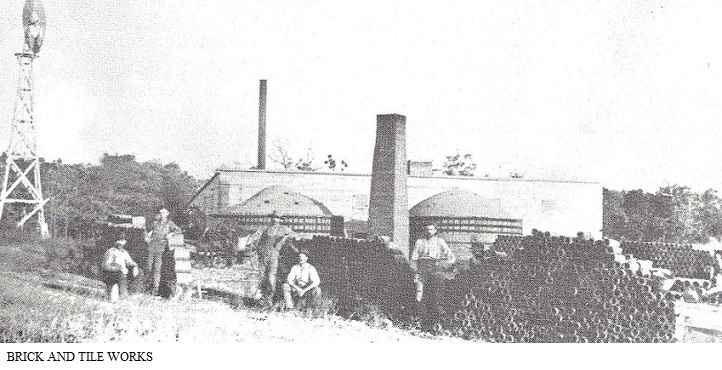 |
T.M. (Milt) Hill and wife, Gussie,
and children moved from Indiana in Minburn in February, 1903. Milt and
an older brother had been operating a tile factory at Barnard, Indiana.
Milt had answered an ad in a Brick and Tile magazine in which John
McFarland of the Minburn plant advertised for a partner.
The following year Harry and Maggie Hill and daughters came from
Indiana, and Harry bought McFarland's interest in the factory. The
brothers made brick and tile and ran the sawmill 1 1/2 miles west of
Minburn for several years. Many farms in this area are still being
drained by tile made by the Hill Brothers.
In 1908 Harry's health wasn't very good so he sold his half of the
business to Milt and began farming. About 1915 or 1916 Milt sold the saw
mill, dismantled the tile factory and began full time farming, later
moving to Minnesota in 1919.
A Mr. Myers and a Mr. Chamberlain had owned the tile factory before John
McFarland. |
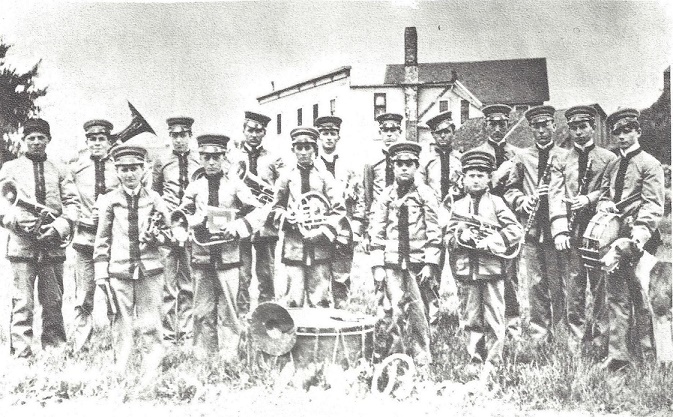 |
| THE MINBURN BAND entertained local
residents at band concerts "away back when". Pictured, from left, are
back row: Sanford Weddle, Clarence McIuie, Clare Basart, Hiram West,
Charles Keller, Jack Boyd, Frank Clement, Ross Boyd, Clem Luellen, Guy
Nourse, and Verbal Danner. Front row: Johnnie Smith, Albert Weddle,
Johnie Edmondson, Dale Shelley and Don Scott. |
| |
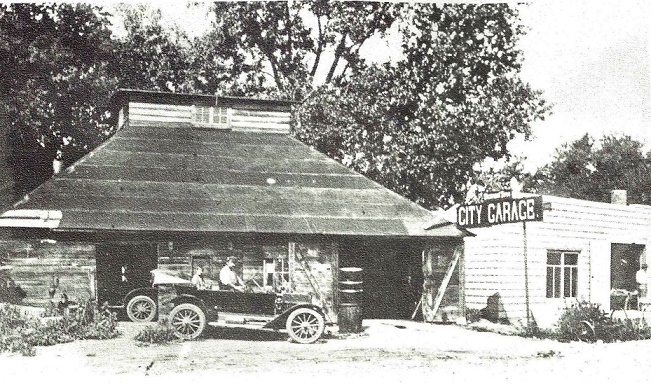 |
| BILL WELCH and GENE WELCH were
seated in an "up-to-date" car in front of the Welch Blacksmith Shop,
when this picture was taken many years ago. |
| |
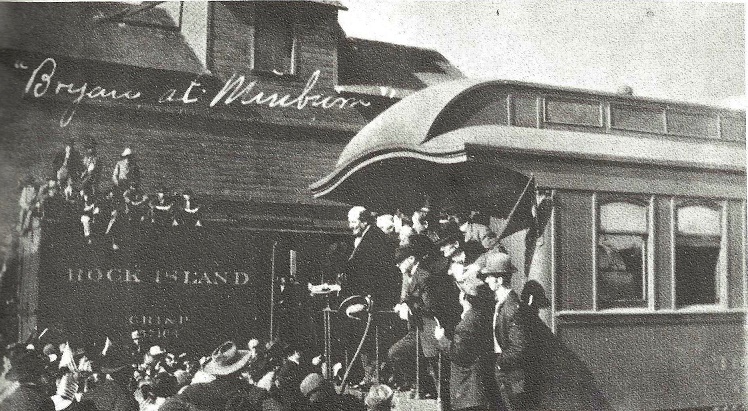 |
| WILLIAM JENNINGS BRYAN, standing at
rear of train, on a whistle stop campaign through Minburn. He was
introduced by W. A. Cook, a staunch Democrat, and grandfather of
Clarence and Howard Hill. |
| |
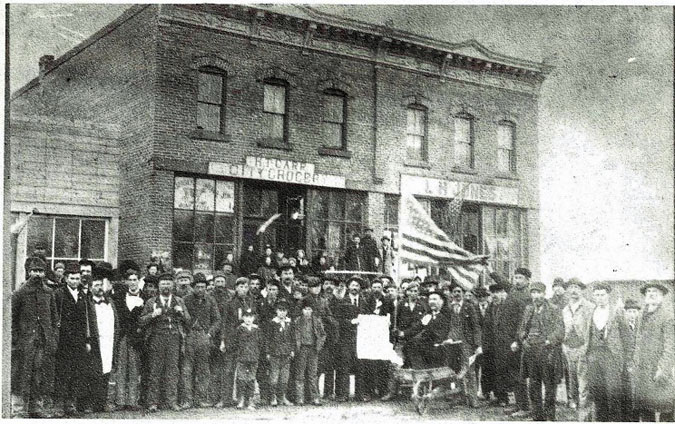 |
| It was a big event in Minburn when
JACK GITZY paid off an election bet by giving L. H. JONES a wheelbarrow
ride down main street. McKinley, republican, had defeated Bryan,
democrat, for President in 1896. Jones, a merchant whose personality and
family left an unforgettable impression on Minburn, was a strong
Republican. Gitzy, editor of the Minburn Star, was a Bryan supporter. No
one had cash money to risk in betting, but occasionally they bet cigars,
labor, or shaving off a beard to back up their convictions. |
| |

EARLY SURVEYOR
Many Minburn residents will find the name of WESLEY VANDERCOOK, pictured
above, on their property abstracts. He was the civil engineer who
surveyed the towns of Minburn, Dallas Center, Perry, and Grand Junction
in 1869.
On his first trip to Iowa, he traveled to Des Moines on a stage coach.
Wesley helped to locate the railroad from Des Moines to Council Bluffs,
which took 14 months. In all that time they did not see a farm or any
town, for that part of Iowa was a vast prairie, swarming with deer,
prairie chickens, ducks, geese and other wild game. There were no trees,
except near Des Moines.
Vandercook then helped survey and build a railroad from Des Moines to
Fort Dodge, which crossed the Chicago North-western. At the completion
of this, he laid out the towns in this area. In 1870 he went to
Springfield, Illinois, where he lived to the age of 96 years.
An interesting story about Wesley, who served in the Civil War, was that
at one time he was pronounced dead and laid in a coffin overnight. The
next morning one of his comrades discovered that Wesley was alive, and
rescued him from a premature grave. |
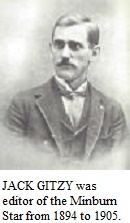
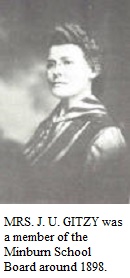
|
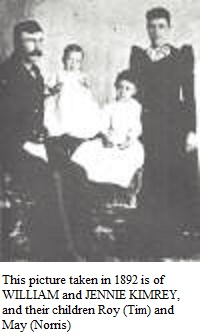 |
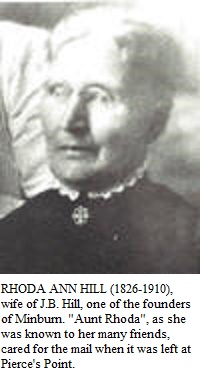 |
 |
| HISTORY OF THE PIERCE FARM |
The histories of many farms in this
area, and their pioneer settlers read like an adventure book. The story
of the present Purl Pierce farm is an example of the hardships sorrows
and joys suffered by our pioneer ancestors.
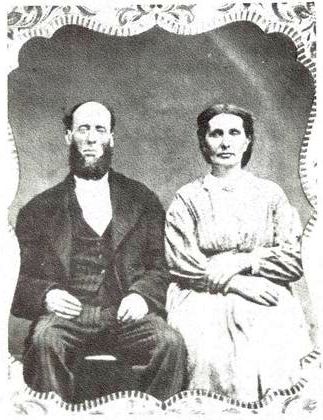 Thomas
and Elizabeth Pierce left Pennsylvania in 1854 with a large caravan of
families, with Illinois as their goal. Their eldest son, Charles came on
to Iowa in 1865 and made negotiations for the purchase of land in Sugar
Grove Township (now Washington Township). Thomas
and Elizabeth Pierce left Pennsylvania in 1854 with a large caravan of
families, with Illinois as their goal. Their eldest son, Charles came on
to Iowa in 1865 and made negotiations for the purchase of land in Sugar
Grove Township (now Washington Township).
A short time later, Thomas and Elizabeth Pierce brought their family to
central Iowa. Along the way they missed the fork in the road and
proceeded to the Harbour Stage Coach stop near Redfield.
Through the efforts of a stage coach driver, the family was re-united in
1866, when the Pierces moved to their new home, the preset Purl Pierce
farm.
Mr. and Mrs. Pierce observed their 55th wedding anniversary on the farm,
living there until his death in 1904. Mrs. Pierce lived with a daughter
in Perry until her death in 1911.
"Jim" Pierce, the youngest son of Thomas and Elizabeth, spent his
boyhood years on this farm. He was married to Myra Campbell in 1894.
Their wedding year was marked by a severe drought and crop failure.
James and Myra lived in their own house on the farm which he later
inherited. Their two children, Isal (Ellis) and Purl were born on this
homestead. Jim and Myra moved to a home in Minburn in August, 1929,
where they celebrated their 50th wedding anniversary in 1944. Their son,
Purl, continued operating the farm and after the death of his parents,
purchased his sister's interest. He was married to Martelle McCarthy in
1925. They have two sons, Gerald (Jerry), and James. Jerry is married to
the former Lynore Connally and lives in Urbandale, Iowa. They have four
children.
James makes his home with his parents and now farms the same homestead
negotiated for by the Pierce family in 1865. He is the 4th generation to
till the Pierce soil. |
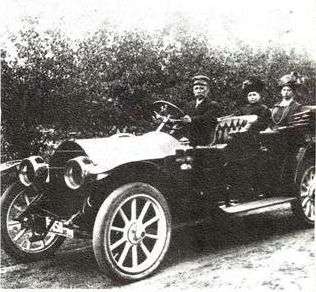 |
| "BARB" GLYDE, his wife Alice and
daughter May, all dressed up for a Sunday drive, in October 1911. |
| ANDERSON BROTHERS - SCENIC THEATRE |
In the summer of 1912, Ray and Oscar
Anderson established a partnership, to be known as the Anderson Bros.,
to provide the residents of Minburn with a Motion Picture Theatre.
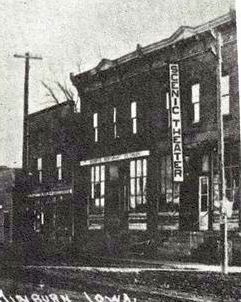 The
SCENIC THEATRE was located in the west room of the Foltz Building, and
with Minburn having no electricity, gas was used in the projection
machine. the first show held on December 21, 1912, was entitled "The
Irony of Fate", followed on January 2, 1913, with "The Holy City", and
"To Err is Human". The
SCENIC THEATRE was located in the west room of the Foltz Building, and
with Minburn having no electricity, gas was used in the projection
machine. the first show held on December 21, 1912, was entitled "The
Irony of Fate", followed on January 2, 1913, with "The Holy City", and
"To Err is Human".
Finding gas unsatisfactory for good pictures, they purchased a Cushman
generating plant which furnished lights and also current for the
projecting machine.
Mason Faber and Lillian Blumberg were the cashiers. Admission for adults
was 10¢, children 5¢.
Many of Minburn's talented musicians accompanied the pictures, namely:
Laura Boyd, Elsie Sundby, Hazel Nourse, Nelle Osborn, Linnie Nourse on
the piano, Russell (Jack) Boyd, clarinet, Verbyl (Cat) Danner, drums,
and Archie Nourse at the Xylophone.
A stage was built and a roll curtain installed and, many fine show
troups entertained Minburn's residents.
In 1914 the entrance and steps were remodeled, and the old Sign removed.
In 1915 the Brothers sold the Theatre to John Marriott of Minnesota, and
dissolved the partnership. Ray engaged in the cement and building trade,
while Oscar, following his marriage to Alma Hagenstein, continued in the
theatre business, purchasing the MAJESTIC THEATRE at Perry from W.J.
Petty. This was located in the I.O.O.F. Building, now occupied by Sidles
Company. After operating the theatre for a short time, they dismantled
it and moved same to Latimer, Iowa, in Franklin County.
Early in 1918, before entering service in World War I, they closed the
theatre, dismantled same and shipped it to Madrid, Iowa, where they
established a partnership with J.W. Coleman, and operated the Theatre in
the Airie Hotel Building. They later sold to Gomer Evans of Madrid, and
moved to Perry, ending their career in the Theatre business. Both
brothers live in Perry, and are now retired. |
 |
| BEN AND KATHIE (MORTIMER) DUGAN were
married March 15, 1899, and lived practically all their married life in
Minburn. A son, Dr. Lester Dugan lives in Minburn, and a daughter, Alice
Robison is from Dallas Center. "Aunt Katie", a friend to all the
children in her neighborhood, kept them well supplied with home-made
cookies. |
 |
| GOLDEN ANNIVERSARIES were quite an
occasion back in the early days. The group pictured above were
celebrating the 50th anniversary of Mr. and Mrs. Newt Brown, seated at
center front. The old Brown home in the picture is the present Bromley
Wooldridge home. |
 |
MR. AND MRS. T.B. THOMPSON*, center
front, are pictured with their either sons and daughters. They are, back
row left to right: Oscar*, Bertha Price of Jefferson, Ebb*, Alf* (father
of Verle Thompson of Minburn), Seated: Art* (father of Glenn Thompson,
Minburn), Lillian Belden of Perry (mother of Henry Belden and Hildreth
Basart, Minburn), Della Thompson, of Perry, Sarah Payton (mother of
Lloyd Payton, Minburn).
*deceased |
| VIRGIL UNTIED |
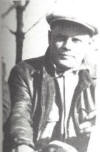 Virgil
Untied, 33, was fatally wounded by three armed bandits on July 23, 1931.
Untied, Night Marshal in Minburn, was shot down in the street without
warning, as he approached a grocery store which the thieves were
ransacking at 3:15 a.m. He suffered five wounds from shotgun slugs. Virgil
Untied, 33, was fatally wounded by three armed bandits on July 23, 1931.
Untied, Night Marshal in Minburn, was shot down in the street without
warning, as he approached a grocery store which the thieves were
ransacking at 3:15 a.m. He suffered five wounds from shotgun slugs.
The bandits robbed four stores in Minburn, and held off several armed
citizens. The shooting took place in front of the depot, as Untied
started across the tracks to the store which was being robbed. His
brother, Jap Untied, and William Hagenstein had accompanied him and were
stationed at each side of the depot when the shooting occurred. The
robbers fled in a car, headed toward Des Moines, and were never
apprehended. |
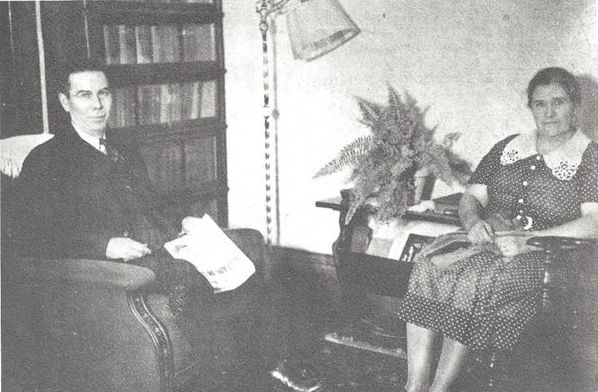 |
| The late DR. JAMES HINCHLIFF and
MRS. HINCHLIFF (ETHEL) are pictured in their Minburn home. They were
married in 1905, the year Dr. Hinchliff started his 35-year medical
career here. He retired in 1940 because of illness, and passed away in
January, 1944. Mrs. Hinchliff, 88, is still living in Minburn, where she
has the distinction of being the oldest woman resident. John of Des
Moines, Iowa, and Dorothy Harper, also of Des Moines, are the son and
daughter of the Hinchliffs. There are also 4 grandchildren and 4
great-grandchildren. |
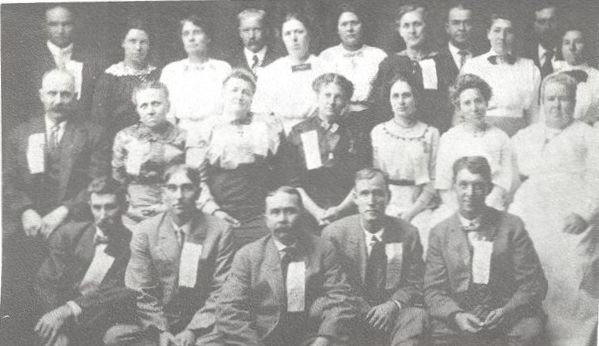 |
| A REBEKAH LODGE Meeting in Adel.
Back row, left to right: George Pritchard, Anna Pritchard, Nettie
Snyder, Will Snyder, Lillian Wicks, Lizzie Craig, Ciddie West, Jerry
Osborne, Melinda Reed, Joe West, Martha Gottschalk. Second row: Henry
Geissinger, Cora Geissinger, Ellie Osborne, Nelle Harris, Effie Mitchell
Dixon, Bertha Wallace Harris, Lizzie Bever, First row: Oscar Bever, Del
Wicks, Dolly Scott, Bert Reed, Sam Harris. |
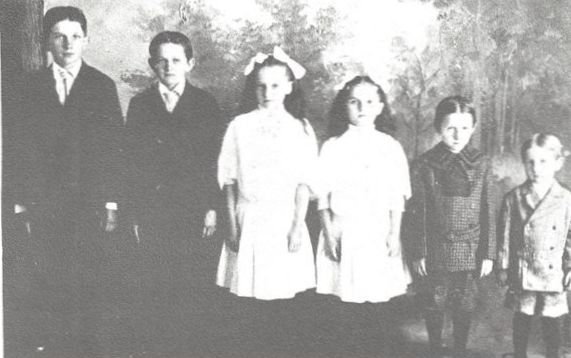 |
The HAGENSTEIN Family, perfect "stairsteps" are from
left: Adolph*, Bill*, Alma Anderson, Perry; Lena Myers, California;
Fred, Minburn; Leo, Aiken, Minnesota.
*deceased |

The family of WILLIAM & ELIZA LUELLEN, in 1896, left to right: Mary
Elizabeth Luellen, Cephus Dodd Luellen, Ruth Dodd Luellen Rogers,
William Wallace Luellen, and Clarinda Luellen Porterfield. |
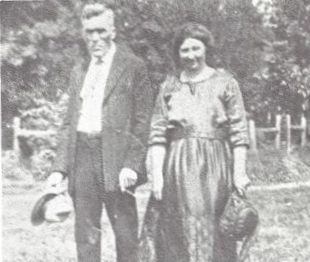
TOM & NORA WEDDLE moved to Minburn in 1912. They raised a family of nine
children, all of whom settled in central Iowa to establish their own
homes. Four daughters live at Minburn, as do 3 grandchildren and 11
great-grandchildren. Their family includes: Maude Thompson, Lola Kimrey,
Nana Royer, and Vera Royer, all of Minburn. Rex, Des Moines; Flora
Wolfe, Perry; and Honor Morgan of Dallas Center. Verdo and Marie Scott
are deceased. Tom passed away in 1944 and Nora died in September, 1959. |
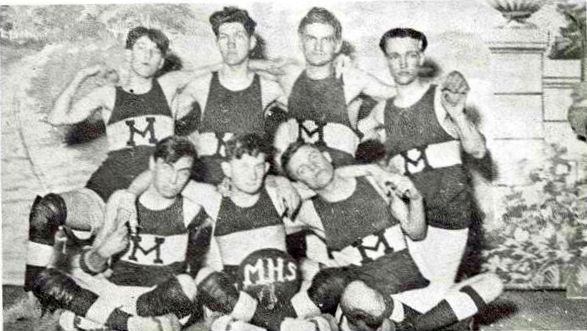 |
| Pictured above is the MINBURN HIGH
SCHOOL Team of 1915. The players are, from left in the front row: Verle
Carris, Don Scott and Paul Goldsberry. Back row: Alfred Weddle, Mac
Shirley, Lovell Burket, and LaVerne Brenton. The picture was taken on
the stage of the old theatre building. |
 |
| Many Minburn residents remember the
horror of the TRAIN WRECK here in September 1917. The fireman jumped
from the engine, ran to a house close by and died in the yard. The
Engineer was buried in the wreckage. |
 |
| This was a meeting of the METHODIST
LADIES AID SOCIETY on the lawn of the old Ed Hill home. Included in the
group are: Mrs. George Miller, Mrs. John Shirley, Mary Slocum Guernsey,
Luie Scott, Mrs. John Slocum, Katie Dugan, Mrs. Newt Brown, Mrs. C.W.
Anderson, Jennie Hill, Gladys Slocum Shirley, Lizzie Luellen, Mrs.
Varley (minister's wife), Mrs. Ed Hill, Pearl Fox, Mrs. L.P. Smith, Mrs.
Ben Nelson. Tjhe two ladies at the left were unidentified. |
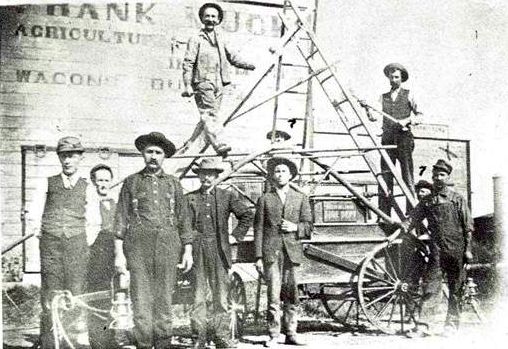 |
| MINBURN VOLUNTEER FIRE DEPARTMENT of
many years ago. "Tinner" Smith at top, Bert Schnoover on ladder. Others,
left to right: John Fultz, Oscar Basart, Gene Welch, Albert Hagenstein,
Ward Belden, Than Weddle. |
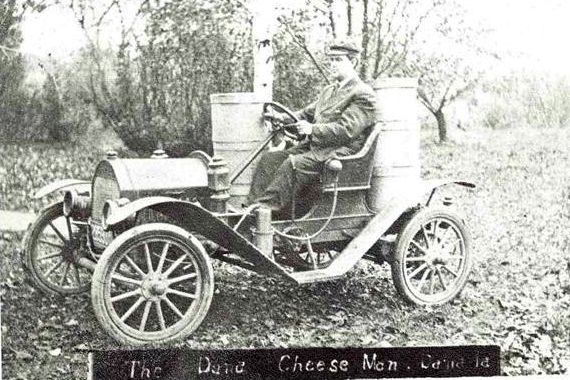 |
| The "DANA CHEESE MAN" brought drums
of cheese to Minburn back in 1912, when this picture was taken. |
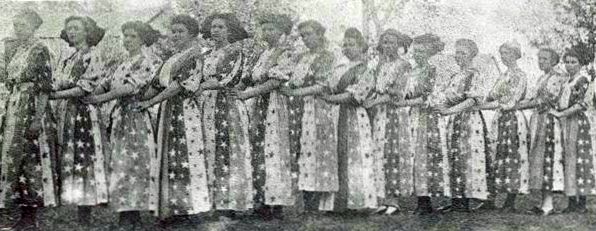 |
THE BAND BOOSTER GIRLS, left to
right: *Gladys Slaughter Bever, Lena Scott West, Pearl Roush Bever,
*Hazel Nourse Luellen, *Clara McQuie, Flossie Gottschalk Kime, *Lynette
Gribben, Eva West Chandler, Marcia Luellen Carris, Ilo Scott Smith,
Bertha Thompson Price, Gladys Luellen Draegert, *Helen West McGrean, *Linnie
Nourse Brenaman, Not present when picture was taken: Jennie Sundby
Untied, Inez Parcel, Mae Burkholder.
*deceased |
| BOOSTER CLUB |
The Booster Club was started by a
group of girls who entered a float in the parade at the Fourth of July
celebration in Minburn in 1908. They received first prize of $10 by
popular vote.
Because there was no place in Minburn to hold celebrations..such affairs
were held in the timber..the girls felt the need of a city park. With
the $10 prize money, they started a Park Fund.
The Booster Club was organized in 1909. In order to raise money, they
sponsored ice cream socials, band fairs, lyceum programs, chatauqua,
dinners, calico carnival, and various other projects.
When the fund reached $500 they had a chance to purchase the Rogers
homestead for $1,000. In order to do this, the club had to be
incorporated. This was done in 1917 by George and Harry Dugan, former
Minburn residents who donated their services.
The Park is known as the Minburn Park.
The Booster girls cared for the park for several years, until it became
too much of a burden for so few, and they they deeded it to the town.
The following is a Rally Song used by the Booster Girls: |
"We are boosters, don't you see...
And we want you to agree,
Just to help boost Minburn to the top;
It's the best town on the map;
We know you'll all agree to that...
Won't you help us be a booster now,
and boost?
Be a booster now, and boost...
That's our motto, don't forget;
Help to boost old Minburn right along;
For we want our town to be
The best town you will see;
Don't be knocking...be a Booster
now...and boost! |
| FOURTH OF JULY |
The Fourth of July was a great time
for Minburn - with festivities centered at the picnic grounds in the
timber one-half mile west of town. The Minburn Cornet Bank reserved its
noisiest music for the great day, and weeks of preparation went into
plans for the program and stunts.
No celebration was complete without the reading of the Declaration of
Independence by Lew Gill. Then of course there was always a speaker, who
thrilled the elders with his oratorical rendition of Independence Day -
much to the unhappiness of the younger set who must sit still and be
quiet!
The annual parade was resplendent with red, white and blue bunting - and
pretty girls! Speaking of parades, one year Dallas Center put on a
parade in which pretty girls rode on decorated floats, each representing
one of the states. Leading them all was the Goddess of Liberty. But they
ran out of pretty girls, so came to Minburn for the Goddess.
Then there was always the greased pig - to be caught by some lucky boy
for a prize. An attempt to climb a greased pole was the crazy
performance of the "rag-muffins". They were all on horseback - dressed
in the craziest, raggedest clothes they could find.
Men in calico mother-hubbards and yellow sun-bonnets rode past the
speakers stand, down to the dance floor. There they all dismounted and
put on a dance. Such a hullabaloo - scaring some of the onlookers nearly
to death! Then the wild men rode off into the woods to remove their rags
and masks.
Later at the Fair ground there were sack races and fireworks and plenty
of ice cream. Thus ended a big day. |
| KIMREY CEMETERY |
Kimrey Cemetery is as old as any
cemetery in Dallas County. The origin of this little cemetery is the
same as occasional others which are found scattered across our land. A
family was traveling westward in search of a place to call home and they
found it necessary to stop because of illness - and the short sad story
is told. "Several of their children died of typhoid".
Mr. John Kimrey gave a piece of ground from his homestead so that the
family could bury their children. Their graves have long since become
lost as there was no stone available for headstones. This little
cemetery of a little over two acres has headstones dating from 1850
onwards.
It is located on a beautiful high knoll two miles southwest of Minburn
overlooking the Raccoon River.
A small headstone with the name of "Jennie" is in memory of Jennie
Mitchell, infant daughter of Jacob Mitchell, who died in 1872. This
small stone could well be in remembrance of the many children who died
in infancy and whose graves are not marked with a stone. The ancient
pine tree has nearly swallowed this small headstone. |
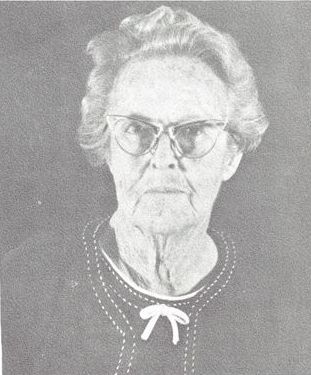
LILLIAN WICKS, 84, has the distinction of having spent the most years,
of any living resident, at Minburn. She was the youngest of the family
of Mr. and Mrs. Henry Voas, and the only one still living. "Cree" has
lived all of her life near the site where she was born. |
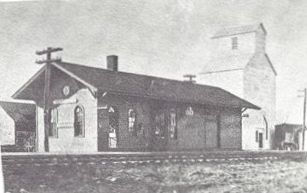
The DEPOT pictured above burned on April 21, 1914. Old timers recall
that Norris Voas, son of Mr. and Mrs. Geo. Norris Voas, was born while
the depot was burning. |
 |
| This picture, taken in 1887, is of a group of early
PIONEERS living in the area of the present John Ross farm, known as the
"Myers Community". When a school district was established, it became the
"Mayflower District". Included are members of the Myers and West
families, and possibly some of the Voas family. |
 |
| Minburn folks were sport-minded even
back in 1912, when this BASEBALL TEAM slugged their way to many
victories. They are, left to right, front row: (unknown, from Dallas
Center), Clem Luellen, Frank Mitchell, Clarence McQuie, Floyd Pierce,
Lee Bryant. Back row: Vic Roush, Ed Thomas, Ariet Stout, Sam Wilson,
Lenny Mitchell, Harry Brenaman, Bobby Thompson. |
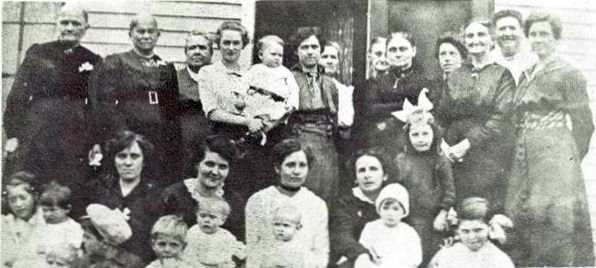 |
| This picture of the C.W.B.M.
MISSIONARY SOCIETY was taken in 1915, in front of the home of Mrs. M.A.
Clements (Picture taken by Bernice Clark Weddle). They are left to
right, back row: Jane Edmundson, Sarah West, Mrs. Oscar Bever, Gladys
Bever and baby, Mrs. Newt Black, Mavis Clement, Martha Murphy, Maud
Nourse, Nettie Morton, Mrs. Osborn, Emma Clark; sitting: Avis Clement,
Opal Bever Dougherty holding Louise black, Blanche Busby, Ada Clement
holding her daughter Marie (Scott), Lizzie Warford and son, Marie Davies
and Gail Clark, Hesper Clement, Olive Clement. Bottom row: Merrill
Clement, Dean Morton, Elery Clement. |
| A CENTURY OF BUSINESS IN MINBURN |
During the past 100 years, many
business establishments have come and gone, in and around Minburn. Of
the present businessmen, Harold Hunter has been in business here the
longest, having started Hunter Oil Company in 1941. Hawbaker Hardware
has been established since 1937 but the present owner, Russell Hawbaker,
succeeded his father in the business.
Going back to the beginning, some of the first business concerns include
the following.
D.F. Rogers and Wallace Luellen started the first lumber yard in 1870.
The first store building was erected east of the railroad tracks by F.H.
Baker, who also had the first house in Minburn. Several store buildings
were built west of the Co-op store site, and all were later moved across
the railroad tracks. Frank Ullery owned and operated a hardware store.
In 1870, Minburn's first saloon was run by Charlie Pierce on the west
side. Later, Dick Ross and Pete Cushman and his wife started saloons,
also.
Mr. and Mrs. Rogers and some friends started the first Public Library in
Minburn in 1873.
The first drug store was run by A.C. Nims. James Lyon, Frank McGraw and
Frank Edmundson were the first blacksmiths. Minburn's pioneer physician
was E.R. Aiken. According to reports, he had no medical school training,
but had studied doctor books with some older doctors. Iowa had no
medical laws then.
Pat Flynn was the official shoe and harness maker. Charles and William
Minnis sold hardware, coming here about 1880. John Esbine N. Welch was a
blacksmith of some renown. Andrew Peterson did draying from about 1870.
Dr. Hinton came to Minburn while Dr. Grossman was here, but stayed only
a year or so. His office was opposite the L.H. Jones Store. J. Kelly
Olds was a merchant during the 1880's. |
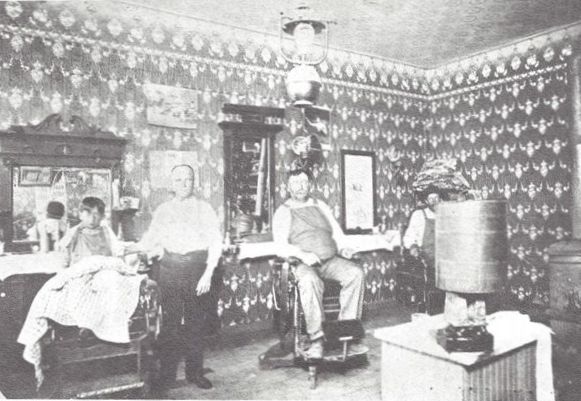 |
| This picture of JOHN SHELLY
(standing) barber shop was taken in 1900. The man waiting for a hair cut
is Bill Kimrey. |
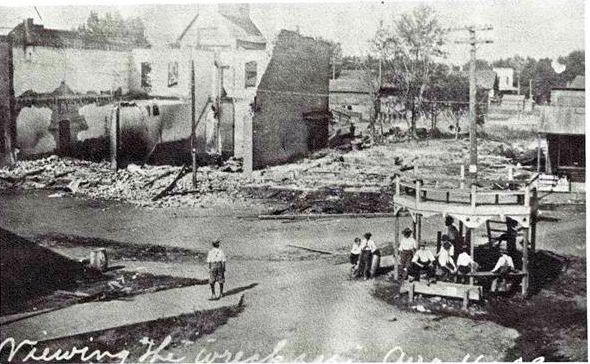 |
| Does this picture bring back fond
memories? The circular BANDSTAND to the right was built around the old
town pump. The wreckage in the background was all that remained after
the fire of 1909, of the buildings south of the Masonic Hall - the
present site of the grocery store and bank. |
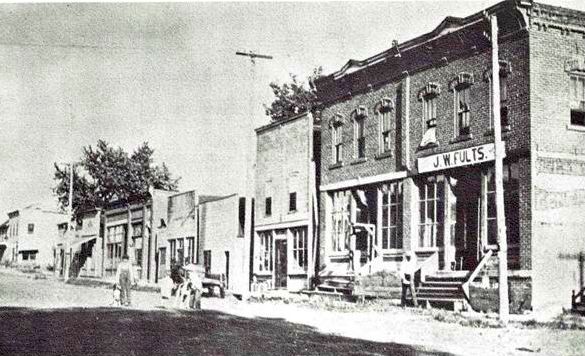 |
| The south side of MAIN STREET in
Minburn many years ago. |
| MINBURN, in 1879 |
(The following information was
derived from a History of Dallas County published in 1879)
In 1879, Minburn School consisted of 2 frame buildings of one room each.
There were 83 pupils, and the two teachers were S.H. Lauder, principal,
receiving $42.50 per month, and Sophie Burnett, assistant at a salary of
$30.00 per month.
Businesses: 2 General Stores, John Warford, and A.J. Knowles; 2 Hardware
Stores, G.F. Brayton & Bro., and Jesse Filbron; Drugs, Wm. Seidler;
Physician, E.R. Aiken; Restaurants, Joll Cushman and Wm. Mitchell'
Blacksmiths, Frank Edmundson, V.W. Beeson, Brown & Gosselin; Livery
stable, John Oakland; Hotels, Frank Knowles and John W. Gillian; Grain
Buyer, M.W. Gribben; Saloon, M.M. Maurer; Cornet Band conducted by Wm.
Osborne. Population: 300. Shipped out of Minburn in 1878: Corn-110,000
bu., Oats-25,000 bu., Wheat-4,000 bu., Hogs-7,500, Horses-18, Butter and
eggs-35,000 lbs.
Storm Saw Mill - owned by Osborne Bros: capacity of 3000 to 6000 ft.
Also a planing mill and lumber yard in connection, and owners were
contractors and builders. |
| PAST BUSINESSES |
It is difficult to recall all of the
business establishments of past years. Here are some which old timers
remember: Shannon's Cafe, Butler's Garage, Steve Gottschalk's Store,
Otis Hays Harness & Shoe Repair Shop, Danner's Store, Nourses Store,
Mattie Bryant's Millinery, Gilbert Clark Plumbing & Heating, and Reves
Produce. Also oil stations operated by Ben Charlet, Art Denman, George
Danner, Glen Schott, and Ralph West. Beauty operators have included
Doris Bender Elenor Mickelson, Gerdena Steward, Fraulein Hays, Mary Ann
Warren, Garnita Wooldridge, and Thelma Miller.
Dr. Little practiced medicine in Minburn for many years, but no definite
information has been made available. Another old time favorite was "peg
leg" Howard, who repaired shoes.
The Raney Motor Co. was operated 12 years by Lewis and Gertrude Raney,
and was sold to Darrell Daugherty in Sept., 1960. When he left Minburn,
the building was converted into a a shop for school use, but is still
referred to as the "Raney Building" "Lew" was quite a favorite around
town, and was very community-minded. They moved to Spencer from Minburn,
and Mrs. Raney passed away in 1969.
More recent businesses have been Smiley Insurance Co., Miller Plumbing &
Heating, Central Service operated by Harold Smith, Gables Coffee Shop,
operated by Mr. and Mrs. Bernard Brokaw, and a sewing shop operated by
Mrs. Verle Thompson. |
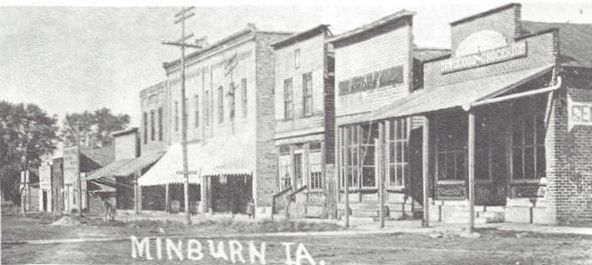 |
| This was the east side of MAIN
STREET - date unknown. |
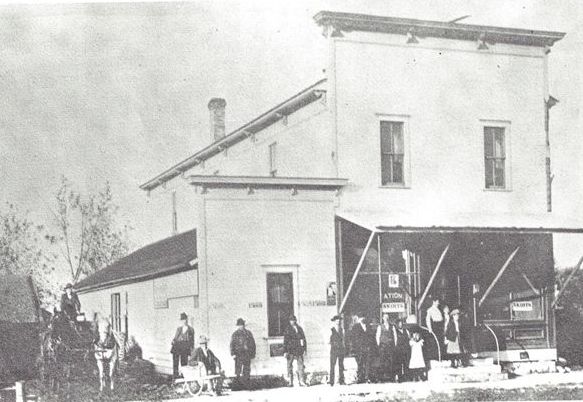 |
| This is the old CO - OPEATIVE STORE
which later became the E.J. Rowe Store, on the site of the present D-X
Station. |
 |
| This picture of HAGERSTEIN'S MEAT
MARKET was taken about 1909. Left to right: Adolf Hagenstein (killed in
France), John Rector, Albert Hagenstein. |
| COMMUNITY-MINDED CITIZENS PAST AND PRESENT |
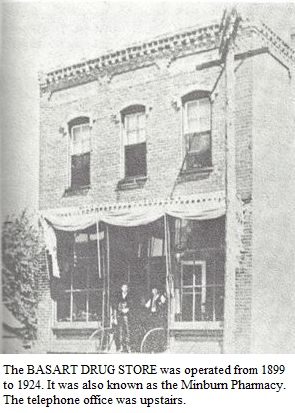 No
history of Minburn would be complete without mentioning several persons
who have contributed much to their community. Of course there are many
others, too, but these few are representative of the fine people who
have helped make Minburn a good place in which to live. No
history of Minburn would be complete without mentioning several persons
who have contributed much to their community. Of course there are many
others, too, but these few are representative of the fine people who
have helped make Minburn a good place in which to live.
MR. AND MRS. E.L. MEEK Professor Meek was School
Superintendent for several years and Mrs. Meek taught. She also served
as Postmaster 12 years. Their home site was given to the town of Minburn
and for years was known as Meek Park. This is the present location of
the skating rink, which is a fitting tribute to this fine couple who
loved all young people.
A.H. NELSON served as depot agent in Minburn 40 years,
1909 to 1949, when he passed away. Mrs. Nelson, 95, lives in Salt Lake
City, Utah, with her daughter, Iris Good. She is a remarkable, person,
and at the age of 85 made a trip to Alaska alone. As of June, 1969, she
was reported in good health.
"AUNT LUIE" SCOTT was a fine example of the old saying,
"you are never any older than you feel". Each year on her birthday,
friends and relatives dropped in to congratulate her and share her
birthday cake. She passed away in September, 1963, at the age of 96.
GRANDMA MARIE CLEMENT, passed away in February, 1956,
at the age of 99. She often assisted Dr. Grossman in the early days.
JOHN BURKET, a pioneer of Minburn, died August 21,
1961, at the age of 90. He was a livestock buying partner of Ed Hill for
18 years in the early days of Minburn.
RAY GRIBBEN, born in Minburn in 1885, served in many
capacities in this community. He passed away in June, 1966 at the age of
81.
EVERETT AND ALMA SHAW owned and operated the Shaw
Grocery for 38 years.. In 1937, Shaw and Howard Hill started the Minburn
Cold Storage Locker, the first in Dallas County, which the former
operated in connection with the store until 1965, when he sold the
business. Through outstanding service, the Shaw's established a name for
their store, and won the confidence and patronage of their community.
Everett was always on hand to help with any community project. He often
made the store available when groceries were needed for serving at the
food stand, even when the necessity arose after the store was closed.
Such folks as these are what keep a small town progressing. They
continue to live in Minburn, where they have many friends.
E. HOWARD HILL A native son of Minburn, Howard
Hill has brought much recognition to his home town through holding
various important positions. Howard and the late Mrs. Hill (Lorraine)
were active members of the Minburn United Methodist Church, and devoted
much time to various worthy organizations. Remaining humble throughout
his successful agricultural career. Howard's main pride and joy have
been his family and home.
MABEL (Mrs. Clarence) HILL is one who can always be
depended upon to help carry the burdens of her neighbors. She is vitally
interested in everyone, and always ready to lend a helping hand in time
of sickness or need. The only reward she needs is the satisfaction of
helping a fellow human being.
Mrs. Kyle (MARY) REED has often been referred to as "an
angel in disguise" by the many grateful people she has helped. Whether a friend or a stranger, anyone needing help in sickness or
adversity, is "adopted" by Mary as her personal problem. Her good deeds
are quietly performed, and her devout faith has inspired many in times
of need and sorrow.
Whether a friend or a stranger, anyone needing help in sickness or
adversity, is "adopted" by Mary as her personal problem. Her good deeds
are quietly performed, and her devout faith has inspired many in times
of need and sorrow.
MRS. PEARL FOX Mrs. Fox served the Minburn
Library in some capacity for about 19 years. She retired in January,
1963, and was presented a Citizenship and Community Service Citation by
the Minburn Woman's Club. She was honored at Open House, with 90 local
persons signing the guest book. Mrs. Fox passed away June 12, 1969.
Carolene Hays was Librarian for several years, and Martha Dugan is
currently serving in that capacity. Mrs. Dugan is interested in all
community projects, and lends a willing hand when needed. She is
particularly interested in the youth of our community. |

